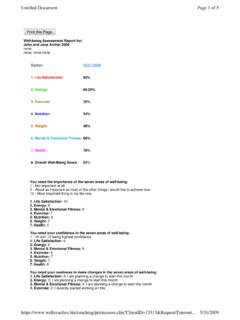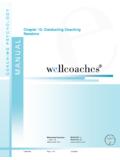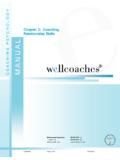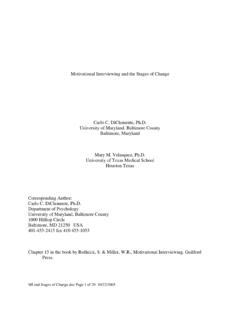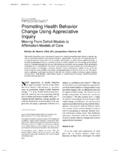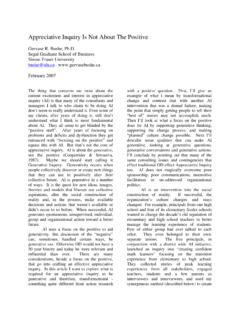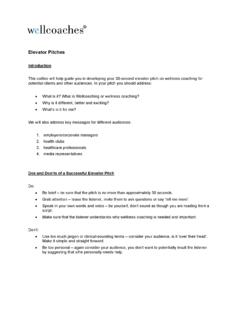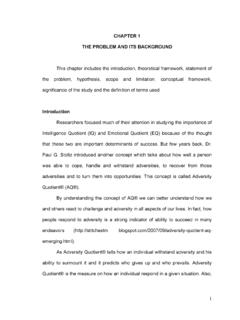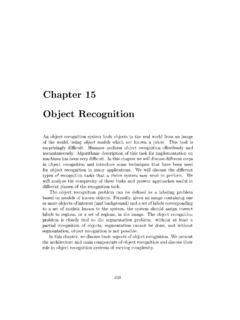Transcription of Chapter 1: Introduction to Coaching - Wellcoaches
1 Confidential Page 1 of 52 5/1/2009 Chapter 1: Introduction to Coaching Confidential Page 2 of 52 5/1/2009 Acknowledgements This manual represents the culmination of almost nine years of work by many colleagues and collaborators. We can t go further without first acknowledging the shoulders on which we stand. Coaching started in sports as games developed with ever more complicated rules and performance expectations. Coaches emerged who taught the game, structured training, gave feedback, and otherwise assisted people to do better. In the early 1970s, a young tennis coach named W. Timothy Gallwey wrote an extremely influential book, The Inner Game of Tennis (1974), which transformed the art of sports Coaching with its revolutionary approach to Coaching and human performance improvement.
2 After Gallwey it wasn t enough to teach the game and give feedback; Coaching had as much to do with assisting people to get out of their own way (the inner game) as with the mechanics of the outer game. With that insight, the modern Coaching movement was born. Since that time, there has been a virtual explosion of books and training on the principles and practices of Coaching . It seems there is no end to where people will go with the science of facilitated human learning. Today more than 30,000 coaches have pursued coach training and serve a $ billion market mostly executive/corporate and life Coaching . We are particularly moved by the vision of Tony Grant, PhD, the first Coaching psychologist who founded the Coaching Psychology Unit at Confidential Page 3 of 52 5/1/2009 the University of Sydney in 2000.
3 His work inspired us to be bold enough to call this manual a Coaching psychology manual. As we ve developed our coach training curriculum we ve been blessed by the early and unwavering support and endorsement of the American College of Sports Medicine, particularly Walt Thompson, PhD, and Jim Whitehead, whose partnership we sought to keep us on target in aiming for the highest possible standards. The first iteration of this manual was developed from 2000 2002 by Margaret Moore, MBA, in collaboration with Steven Jonas, MD; Gabe Highstein, PhD; Juli Compton, PhD; Sheryl Marks Brown, BA; Kate Larsen, BS; Joan Price, MA; and Tony Rodriguez. Important contributions from others followed quickly, including Walter Thompson, PhD; Robert Rhode, PhD; Lori Gray Boothroyd, PhD; Pam Schmid, BS; and Jessica Wolfson, BS.
4 Gloria Silverio, MA, led a complete editing of the manual in 2006 as well as bringing significant and new content. Carol Kauffman, PhD, Gloria Silverio, and Jessica Wolfson helped us integrate important tenets of positive psychology throughout the manual. The LifeTrek Coaching team, led by Bob Tschannen-Moran, MDiv, and Erika Jackson, MA, spearheaded an enormous effort in 2006 and 2007 to expand the curriculum by further integrating tenets of positive psychology, strengths-based change strategies, nonviolent communication, and relational flow (the intuitive dance of Coaching ). They also spearheaded the effort to structure the curriculum in accord with adult learning theory and to align the curriculum with our ACSM- Confidential Page 4 of 52 5/1/2009 endorsed coach certification, creating wonderful checklists and guides that are incorporated into this manual.
5 The team which developed a theoretical model for relational flow the intuitive dance of Coaching brought important background to support our Coaching model, including Margaret Moore, David Drake, PhD, Bob Tschannen-Moran, Francine Campone, PhD, and Carol Kauffman, PhD. Carol and Margaret developed the material which is the foundation for a new Chapter called Coaching Presence which teaches the being skills of Coaching . The final draft of this manual was reworked in 2007 and 2008 by Bob Tschannen-Moran and Margaret Moore. We would not have completed the manual without the tireless efforts of the Wellcoaches operations team to support all of us, led by the indefatigable and one-of-a-kind Jeff Cramer. We want to acknowledge all of the Wellcoaches faculty members who also serve as mentor coaches, including Blaine Wilson, MS, Christina Lombardo Ray, MA, and Michael Scholtz, MS, for their dedication to teaching and mentoring coaches to master Coaching competencies and for calling us to continually refine the manual.
6 Most importantly, our coach trainees have contributed substantively to the evolution and presentation of Coaching skills and processes. They have challenged us to make them elegantly simple to practice and use. In fact, Chuck Schroeder, MS, nuclear engineer and now executive Confidential Page 5 of 52 5/1/2009 wellness coach, even created a streamlined version of a sample well-being assessment. All of us enjoy using these principles and practices every day to support both our own and our clients health and well-being. Not only have we all undergone personal transformations, we are incredibly fortunate to be partners in the small and large transformations that our clients experience. It s rewarding beyond compare. Coaching is our future. Margaret Moore, BS, MBA Founder and CEO Wellcoaches Corporation Bob Tschannen-Moran, MDiv, IAC-CC, CWC Wellcoaches Faculty President, LifeTrek Coaching International Confidential Page 6 of 52 5/1/2009 Chapter 1 Introduction to Coaching I saw an angel in the stone and carved to set it free.
7 Michelangelo Chapter Contributors: Margaret Moore, Bob Tschannen-Moran, Gloria Silverio, and Lori Gray Boothroyd Welcome to the Wellcoaches Coaching Psychology Manual. This manual is designed to teach basic Coaching skills and processes. When we use the term coach throughout the manual, we are referring to health coaches, fitness coaches, and wellness coaches. After reading this Chapter , you will be able to: Distinguish between wellness, health, and fitness coaches Distinguish among business, life, wellness, fitness, and health Coaching Define why we need professional coaches in physical and mental wellness Distinguish between Coaching and the expert approach of health and fitness professionals Define Coaching and identify the value of the coach/client partnership.
8 Confidential Page 7 of 52 5/1/2009 Understand the key components of Coaching psychology Describe the Wellcoaches process of Coaching Distinguish between Coaching and therapy Outline a Professional Coach Code of Ethics Define Liability and Scope of Practice guidelines What Is Coaching ? Coaching is, to quote W. Timothy Gallwey, the art of creating an environment, through conversation and a way of being, that facilitates the process by which a person can move toward desired goals in a fulfilling manner (2000, p. 177). When those goals have to do with health, fitness and wellness, Coaching becomes a vehicle for assisting people to achieve a higher level of both physical and mental well-being. In order to create such an environment, coaches use evocative more than didactic approaches with clients.
9 We do more listening than talking, more asking then telling, and more reflecting than commenting. Coaching is not mainly advising clients on how to solve problems, nor educating clients about what they should do, nor analyzing the root-causes of client predicaments. Although advising, educating, or analyzing problems are on occasion a part of Coaching , they are neither the primary purpose nor approach of Coaching . Coaches are collaborative and co-creative partners in clients journeys to reach their visions and goals. Confidential Page 8 of 52 5/1/2009 Distinguishing Among Wellness, Health, and Fitness Coaches Wellcoaches has clarified the scope of three coach types in the health, fitness, and wellness arena. Wellness coaches are credentialed health, fitness, and mental health professionals (including personal trainers, cardiac rehabilitation specialists, dietitians, health educators, physical therapists, nurses, physicians, and behavioral health therapists) who coach clients on evidence-based areas of wellness or well-being physical activity, nutrition, weight, stress, and life satisfaction.
10 While wellness Coaching has a broad scope, coaches provide expert guidance and advice, when called for and where clients lack expert knowledge, only in the areas where they have professional credentials. Health coaches are credentialed healthcare professionals (including nurses, nurse practitioners, physician assistants, clinical exercise physiologists, and physicians) who combine Coaching with their expert knowledge to assist their patients and clients to manage medical conditions such as heart disease, diabetes, arthritis, and cancer. Fitness coaches are credentialed exercise professionals including cardiac rehabilitation specialists, exercise physiologists, certified personal trainers, or group exercise instructors, who use Coaching skills to enhance personal training and fitness instruction outcomes.
